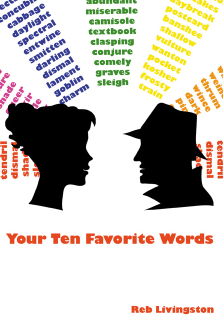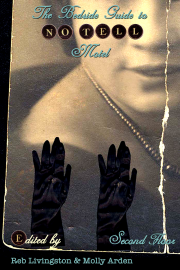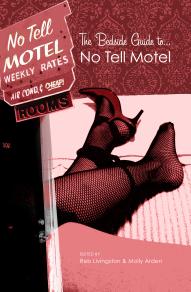How I Published My First Anthology and Made All My Book Making Dreams Come True
At the time, I felt like a nauseous slug and my memory of my pregnancy is that I spent the majority of it lying on the sofa. In hindsight it was an extremely creative and productive time for me -- in every sense of the word. Aside from building a human being in my womb, I wrote many poems, a long collaborative poem, made home improvements to almost every room in my house, started an online magazine (I'll talk more about that tomorrow) and continuously came up with project ideas. One of those ideas was The Bedside Guide to No Tell Motel. While I truly had no concept what motherhood was going to entail, luckily I had the foresight not to start this project until many months after my son was born.
I always wanted to edit and publish books, but for a long time thought it wasn't a possibility because I didn't live in New York or Boston. I thought I'd have to get a job at a publishing house as a poorly paid assistant and slowly work my way up to poorly paid editor. But thankfully with advances in technology, I can be a big-time, no paid publisher right here in Reston, VA -- from the luxury of my chaise lounge. I'm not being sarcastic, I really like working from my chaise lounge. I'd put it up in my office, if there was any room for it.
Towards the end of my pregnancy, I was reading a lot of poetry submissions for No Tell. I had the idea of creating a book that focused on sensual poetry --not erotica, per say-- but the passionate. I ran the idea past my No Tell co-editor, Molly Arden, she was game too. Around that time I purchased a print supplement put out by another online magazine and was impressed with the quality of the printing and paper. This magazine used Lulu -- and it didn't cost the magazine anything to offer this supplement because it was POD. They didn't have to pay for distribution, no short run, they designed the cover and did the layout themselves. They uploaded the files and wa-la, it was available for purchase to anyone who wanted it.
That was very appealing to me. Although I didn't want to do a print supplement to my online magazine. I don't have print envy. The poems at No Tell are available anywhere in the world (with Internet access) for free -- print can't beat that, print can't even come close. That's not an online is superior to print statement, it's an honest assessment of my personal values. I edit and publish a magazine to connect poems to readers -- No Tell Motel does that very successfully. Even the most successful No Tell Book title hasn't reached the number of readers No Tell Motel reaches in a single day. Once in an interview promoting The Bedside Guide the interviewer commented on how the book must be bringing a lot of attention to the online magazine -- wrong, it's the complete opposite. The online magazine is what brings attention to the books. That's one of the reasons I continued on with the "No Tell" branding when I started the press. People recognize it.
In the summer of 2005 Molly and I put out a call for poems and re-read every poem in No Tell archives and made some selections from that. Over the next six months we assembled a collection of 165 pages by 88 poets, some previously published in No Tell and many never before published poems. I tried to layout the book with MS Word, but became incredibly frustrated. I bit the bullet and purchased InDesign. It took me a couple weeks to figure out how to use it, but once I did, I was quite satisfied and use it to layout all my books. Admittedly, I don't use 80% of the software's features. If you're just going to publish one book, I wouldn't recommend spending the money. But if you plan on laying out lots of books, it's something to consider.
We sent out galleys. Then Molly and I both proofed it and had a couple friends proof it too. I'm happy to say the book is clean. I wish I could say the book was complete. You see, after I sent out all the contributor copies, one of the contributors wrote and asked where his poem was. His name was on the back cover, his bio was in the contributor notes, but his poem wasn't listed in the TOC or appeared anywhere in the book. I was mortified. Apparently I never included his poem. I went through every single acceptance e-mail and discovered another poem that didn't appear. There was a flaw in my proofing process: I was working from the TOC -- and since those two poems weren't in the TOC, nothing seemed amiss during our many proofings. Neither poet thought it odd that they didn't receive galleys (even though I sent out a message to all contributors announcing all galleys had been sent) so no flags on that end until the book was finished. I was really upset when I discovered the second missing poem, I threw my glasses across the room and started crying. Chris gave his patented bewildered stare. I nearly killed myself trying to make the book perfect and it was clearly flawed.
Amends were made, both poems appear in the The Bedside Guide to No Tell Motel -- Second Floor -- and I hope both contributors are satisfied, but there's nothing I can do to make up for that initial disappointment I created. I have empathy for their situation. My work has been accepted for publication and been left out before too, I've been published as "Rob" Livingston and other unfixable errors. It happens at all levels of publishing. I often find typos and errors in books from big publishers. To err is to err. For the second Bedside Guide I created an entirely different proofing system in a spreadsheet with multi checklists that made leaving anything out damn near impossible.
Unfortunate incident aside, the first Bedside Guide was a successful test. I did it to learn if I enjoyed editing and publishing books. If I didn't, it would just be a single book associated with an online magazine. As it turns out, I did enjoy it and it became the first title on the list of a new poetry press.
I should note that publishing an anthology costs considerably more than a one-author collection. You will not be publishing an anthology for $500. That's because there are a lot of contributor copies to print and postage (mailing out these copies). It's my opinion that if you're going to publish a book, you are obligated to give every contributor a copy.
Labels: publishing






4 Comments:
Chaise Longue : “Chaise longue” (literally “long chair”), pronounced—roughly—“shezz lohng” with a hard G on the end became in English “shayz long.” Many speakers, however, confuse French chaise with English “chase” and French longue with English “lounge” (understandable since the article in question is a sort of couch or lounge), resulting in the mispronunciation “chase lounge.”
-- factchecker Glenn
Had you used Quark before Indesign or was the program totally new to you? Just wondering what the learning curve would be for someone who learns quickly but who's never worked much in Quark or even earlier book-making programs. And did you teach yourself or did you have help? (I fear Indesign, clearly).
Hah, thanks Glenn, but I will likely continue in my ignorance, I am an American after all :)
Lynn, InDesign was totally new to me -- I taught myself with the book that came with it. It took me a little while, but once I figured it out it was pretty intuitive.
I discovered your blog from Cherry Pie Press. I had a similar experience publishing our writing group's first anthology. Thought I had it perfect SEVERAL times, even with seven proofreaders, but I'd left poems out of the Table of Contents. We were able to pass around proofs and send links to an online proof, so we "only" printed four advance copies.
Here's a link to our book "In the Moment - Writing from a Spacious Heart" on Lulu, which I hope is now "perfect."
http://www.lulu.com/content/2346480
We would love to hear comments and suggestions!
mschanuel@mac.com
Post a Comment
<< Home